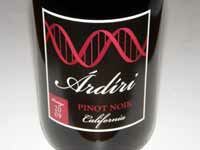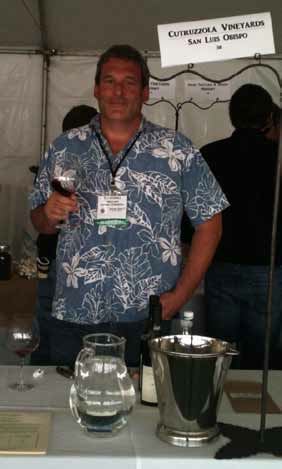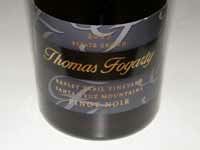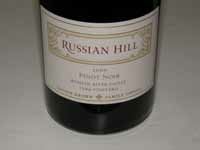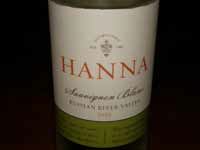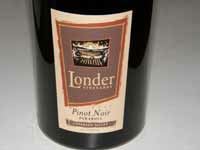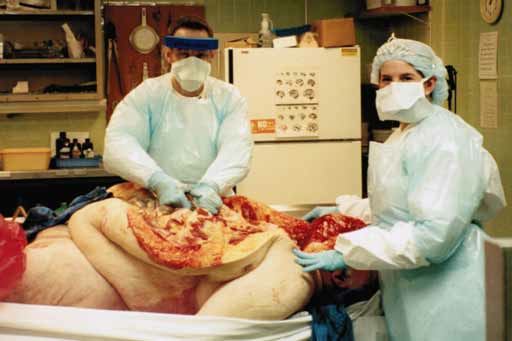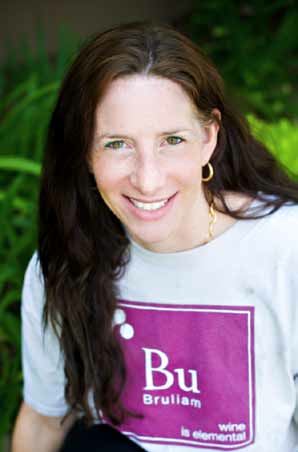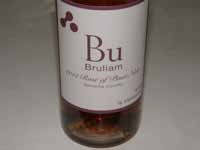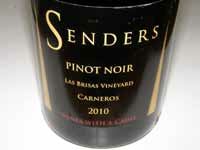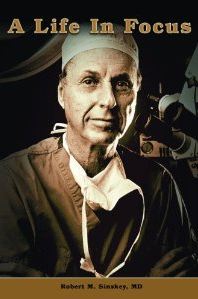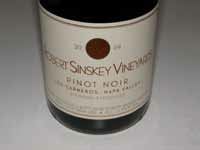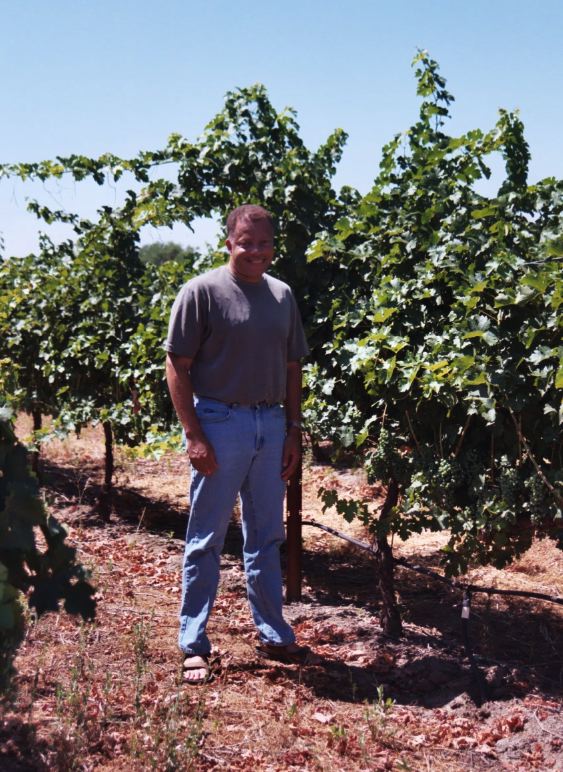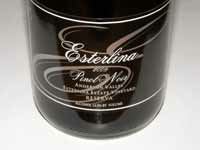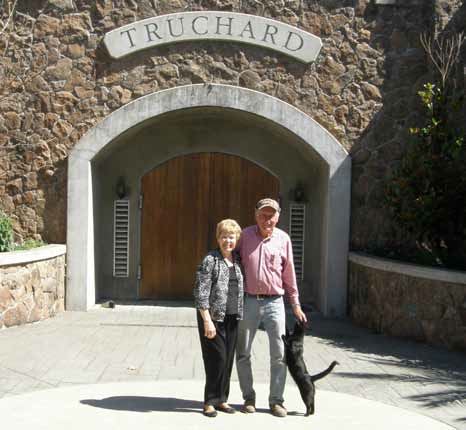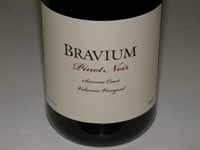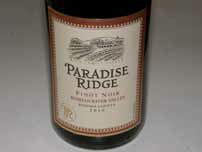California Pinot Noir Doctors
“I tend to judge doctor winemakers by the color of their hands in October”
F. Wells Shoemaker, M.D.
David Bruce, M.D.: David Bruce Winery
Medical School: Stanford University School of Medicine
Residency: University of Oregon Medical School Hospital 1960
Board Certification: Dermatology
Dr. Bruce is an iconic winemaker whose combination of scientific curiosity and passion led him to become one
of the first to produce credible Pinot Noir in California. Although he is now 83 years old and no longer involved
to a significant degree in the winery, his legacy is firmly established. I last saw him at both the 2009 World of
Pinot Noir and the 2009 Pinot Noir Summit where he was said to be organizing his memoirs for inclusion in a
book about his extraordinary career. Mark Greenspan (Wine Business Monthly June 2011), who worked with
Bruce’s vineyards since 2006, found him still active, serving as executive winemaker, and holding weekly
tastings with his staff. Greenspan said, “David Bruce did Pinot before Pinot was cool.”
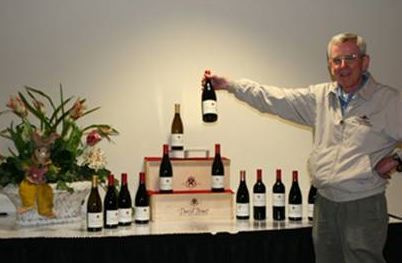
Born in San Francisco, he was said to have his wine epiphany while attending medical school when he bought
a bottle of 1954 Richebourg that cost him a large sum for the time - $7.50. He became inspired by the book
Wines of France by Alexis Lichine, and intrigued with the Pinot Noirs made in the Santa Cruz Mountains by
Martin Ray. John Haeger (North American Pinot Noir 2004) notes that Bruce considered Ray’s Pinot Noirs
better than those of Domaine de la Romanée-Conti. While in Oregon for his residency, he was said to have
made wine, and considered staying there to establish a winery. This was about the time Richard Sommer
traveled to the Umpqua Valley from California and planted the first post-Prohibition Vitis vinifera including Pinot
Noir in Oregon in 1961.
The lure of the Santa Cruz Mountains won out. He bought 40 acres there in 1961, coinciding with the start of
his dermatology practice in Los Gatos. He cleared the land and planted 25 acres of vines by hand including
Pinot Noir in 1962. A winery was built on the site, which was bonded in 1964.
The first commercial release of David Bruce Winery Pinot Noir came in 1966. Dr. Bruce bought another
vineyard in the Vine Hill subregion of the Santa Cruz Mountains in 1968 that was formerly owned by the
Pesenti-Locatelli family. He pulled out the Zinfandel planted there and replanted the vineyard to the Wente
clone of Pinot Noir on its own roots. Ken Burnap, a restaurateur from Southern California was impressed with
the Pinot Noir produced from Bruce’s vineyard, and bought Bruce’s 26-acre vineyard in 1974, renaming it
Santa Cruz Mountain Vineyard.
Dr. Bruce was an innovator who traveled frequently to Burgundy and became one of the first California
winemakers to use whole berry fermentation and whole clusters for Pinot Noir, and to advocate foot crushing of
the cap, the use of rotary presses, extensive skin contact, and small barrel French oak fermentation. Bruce’s
early Pinot Noir wines were uneven and he was to say, “Pinot Noir is the Dune of winemaking,” referencing the
science fiction novel. He had well-chronicled challenging problems with cork taint ( his cork disaster in 1987
cost him $2 million in lost business according to George Tabor writing in To Cork or Not to Cork) and
Brettanomyces, but his Pinot Noir wines eventually achieved widespread acclaim by the 1980s. By then, he
easily sold out the 30,000 cases of wine he produced. He was one of the first California winemakers to
produce a Blanc de Noir, a white Zinfandel, and late harvest wines, and became known for Petite Sirah as well.
Early on, he was most known for Chardonnay, and his 1973 Santa Cruz Mountains Chardonnay was one of
twelve California entries to participate in the famous 1976 “Judgment of Paris.”
One of Dr. Bruce’s legacies will be the “David Bruce Clone” of Pinot Noir that was discussed previously in detail
in the PinotFile: www.princeofpinot.com/article/1223/. Cuttings from David Bruce’s vineyards have been
distributed throughout California.
For 25 years, Dr. Bruce practiced dermatology while making wine at night and on the weekends, eventually
deciding to devote himself completely to winemaking in 1985. Because of his medical background, Dr. Bruce
was also one of the first to extoll the health virtues of drinking wine years before the 1991 appearance of the 60
Minutes television program on the French Paradox. He published a booklet titled, Ten Little Known Medical
Facts About Wine That You Should Know.” He was one of the first doctors to publicize that resveratrol in red
wine increases good cholesterol and reduces bad cholesterol. He recommended that hospitals have wine on
the patient menus, and encouraged a glass of wine for the elderly to improve their appetite and raise their self esteem.
He also defused the hysteria about sulfite allergies to wine and elevated lead levels in wine.
Today, the 16-acre Estate Vineyard, located at 2,200 feet in the Santa Cruz Mountains, has 9 acres planted to
Pinot Noir and the rest to Chardonnay in addition to a recently planted block of Riesling. The original plantings
were destroyed by Pierce’s disease by 1992, and the Estate Pinot Noir program was resumed in 1996 when
new plantings reached maturity. The new plantings came from budwood from the nearby Noble Hill Vineyard
that had been planted in the 1980s with cuttings from the original Estate Vineyard plus several other clones.
The winery sources grapes from over thirty growers throughout California representing ten different
appellations. The Estate Pinot Noir is the signature wine in the David Bruce lineup, but of the 60,000+ case
annual production, most of the Pinot Noir over the last decade has been pretty ordinary appellation-designated
Pinot Noir. Some limited production vineyard-designated wines are offered in the tasting room on Bear Creek
Road which is open daily. The website at www.davidbrucewinery.com is woefully outdated with the Pinot Noir
releases listed from the 2000 vintage.
For more historical information on David Bruce, consult The David Bruce Winery: Experimentation, Dedication
and Success, from the Regional Oral History Office, The Bancroft Library, University of California, Berkeley at
www.archive.org/details/davidbrucewinery00brucrich. Some of the information I have included here should be
credited to this source. A reliable history of the winery is also detailed in John Haeger’s North American Pinot
Noir (2004).
2009 David Bruce Appellation Series Russian River Valley Pinot Noir
14.7% alc., $40.
·
Dark reddishpurple
color in the glass. Aromas of black cherries, black currants, cola and bark. Very ripe and sweet flavors
of dark fruits with a hint of cola. Dense and plush with balanced tannins and acidity, leaving a touch of heat
behind on the finish. Decent.
2010 David Bruce Appellation Series Sonoma Coast Pinot Noir
14.7% alc., $40.
·
Moderately light reddishpurple
color in the glass. Raisin-toned fruit aromas with notes of dark chocolate and oak. Very ripe black
cherry and black raspberry flavor with svelte tannins and a good cut of acidity on the finish. A mainstream
Pinot that became less attractive over time in the glass. Decent.
2002 David Bruce Estate Santa Cruz Mountains Pinot Noir
14.1% alc., $55.
Estate vineyard. Unfined and unfiltered.
·
Moderately dark reddish-purple with
slight bricking of the rim in the glass. Lovely bouquet of an aged wine including
old book, vitamin, tobacco and old wood. Satisfying flavors of black cherries and
sassafras backed by firm, grainy tannins. The fruit is still alive and vivid. Drink
up. Very good.
2007 David Bruce Estate Santa Cruz Mountains Pinot Noir
14.7% alc., $55. Estate vineyard. Unfined and
unfiltered.
·
Moderately dark reddish-purple color in the glass. Shy aromas of black cherries, berries and oak.
Mid weight red fruit core with good intensity. Soft in the mouth and firmly structured with muscular dry tannins,
finishing powerfully but with a little heat. The tannins tend to overpower the fruit. Good.
John Compagno, M.D., MBA: Árdiri Winery & Vineyards
Medical School: St. Louis University School of Medicine 1971
Residency: Washington University St. Louis
Board Certification: Separately boarded in Anatomic Pathology, Clinical Pathology and Hemato-pathology
Advanced Training: Associate at Armed Forces Institute of Pathology and trained in Laboratory Medicine as a
Naval officer at the Naval Regional Medical Center in Oakland, California. He received his MBA from
the University of San Francisco in 1997.
Dr. Compagno is the owner and Medical Director of West Coast Pathological Laboratories in Hercules,
California, a company first established in 1985. He has been practicing medicine since 1971 and pathology
since 1974, and has authored several peer reviewed publications on pathology.
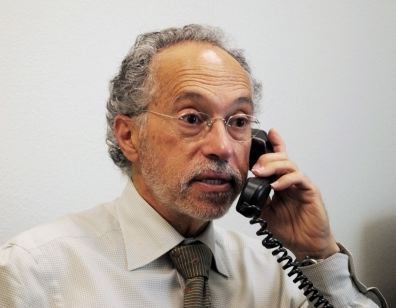
While living in Napa, Dr. Campagno wanted some insight into the wine industry and began taking evening
classes on viticulture and enology at Napa Valley College while working his day job as a pathologist. While
taking classes, he contacted a young realtor to assist him in finding property. The realtor suggested he take at
look at the 5-acre Carneros Vineyard planted to Pinot Noir belonging to Gary Andrus who owned Gypsy Dancer
Estates at the time. He considered the vineyard workable if he did the farming and bought it in 2006. One of
the conditions of sale was that Gary Andrus would take him on as an apprentice for three years but it was a
tumultuous time for Andrus and the apprenticeship never developed. Gary Andrus passed away in 2008.
The vineyard had been neglected and served as a challenge. The realtor’s young husband was a vineyard
manager at Saintsbury Vineyard, about 100 yards from the property, and he offered to be his vineyard
consultant. He ended up being a great resource. To this day, Dr. Compagno is involved in the vineyards
directly and hands on from harvest to barreling when possible. He farms the Carneros vineyard, usually on
weekends, with occasional help from a crew from Pine Ridge Winery, another former property owned by Gary
Andrus. An employee and contracted crew take care of the vineyard in the Willamette Valley.
Dr. Compagno is also the winemaker and Gail, his business partner, helps with winemaking and blending
decisions. Once Gary Andrus and others gave him the principles of winemaking, it has been a matter of “on
the job” production and learning.
Dr. Compagno also bought Gypsy Dancer Estates in the Chehalem Mountains from Gary and Christine Andrus
in 2008 and renamed it Árdiri Winery & Vineyards. Árdiri means “taking a risk” in Sicilian. The property
consists of 13.5 acres of Pinot Noir, Pinot Blanc and Pinot Gris. A tasting room was added to the property that
is open on Friday, Saturday and Sunday and Wednesday and Thursday by appointment.
Dr. Compagno produces Pinot Noir from both Carneros and Oregon, as well as a blend of grapes from the two
regions labeled “Due Stati.” The website is www.ardiriwine.com.
When asked why physicians are attracted to the wine business, he told me the following. “I suspect that there
is a certain aura about wine, the history, the international character, the global business, as well as the
perception that it is an easy entry with an inherent charm. A touch of arrogance doesn’t hurt. In my case, I
have a background in chemistry and microbiology, perfect for understanding the procedures and principles.
Many of my associates over the years have assumed that it is just a hobby with me. However, it is not. It is
both an avocation and a business, and I receive great satisfaction when someone enjoys my wines so there is
creativity at work here as well.”
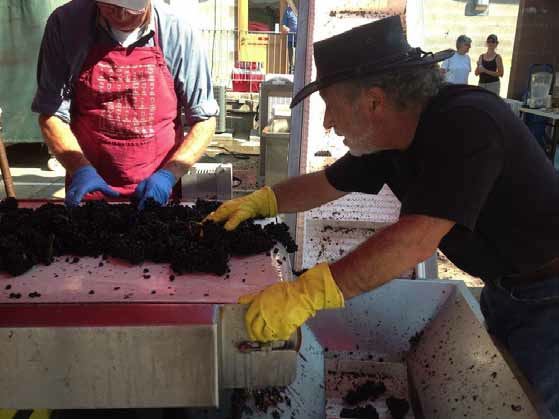
2011 Árdiri Pink Tractor Willamette Valley Rosé
12.7% alc., 75 cases, $N/A. Estate grown. 50% whole
cluster, fermented at cool temperatures.
·
Delicate pink-orange color in the glass. Very nice aromas of
tangerine and golden apple. Bright and crisp, with flavors of strawberries, blood oranges and tangerines. Very
easy to cozy up to and about as pleasurable as rosé gets. Very good.
2009 Árdiri Vineyard Select Chehalem Mountains Willamette Valley Pinot Noir
15.5% alc., $29.
·
Medium
reddish-purple color in the glass. Not particular expressive nose with delicate aromas of very ripe black fruits
and oak. Unusual heft and ripeness for Oregon although 2009 was a warm vintage. Flavors of black plum
reduction sauce, blackberry jam and black tea with muscular tannins in the background. Too ripe for my taste.
Decent.

2009 Árdiri California Pinot Noir
14.7% alc., 640 cases, $29.
Sourced from the estate Carneros vineyard and includes clones 828,
777, 667, 115 and heirloom selections. Moderately light reddishpurple
color in the glass. Fragrant with
·
Moderately light reddishpurple
color in the glass. Fragrant with aromas of dark cherries,
strawberries and sandalwood. Very enjoyable with refreshing flavors
of dark red cherries and berries brown baking spices, supported by
modest fine-grain tannins. Very smooth and easy to like. Very good.
2009 Árdiri Due Stati Oregon/California Pinot Noir
14.5% alc., $N/A. “Two states.” Produced from seven
clones, aged 18 months in French oak and barrel selected.
·
Moderate reddish-purple color in the glass. Shy
aromas of slightly roasted black fruits, brewed tea and oak. Flavors of dark berries and plum that veer to the
ripe side with a hint of carmelized oak. Good mid palate intensity and follow through on the finish with
balanced tannins. Chehalem Mountains fruit dominates the flavor and stylistic profile. Good.
Frank Cutruzzola, M.D.: Cutruzzola Vineyards
Medical School: Yale University Medical School 1988
Board Certification: Diagnostic Radiology
Dr. Cutruzzola (“koo-troot-ZOL-a”) is a practicing radiologist in Santa Rosa, California, at Sutter Medical Center
and Santa Rosa Memorial Hospital. He became interested in wine in medical school and still fondly recalls a
bottle of Vosne-Romanée he enjoyed on his shoestring budget at the time. He noted, “It took half the bottle to
realize how great the wine was, and the second half was gone before I knew it.” Unfortunately, he has no idea
of the producer or vintage, but that bottle left him with a thirst for Pinot Noir.
Several years later, he moved to California with a notion to buy land and grow Pinot Noir. In 2000, he found a
suitable property for sale seven miles east of the town of Cambria on California’s Central Coast that he
considered an ideal cool climate site for Pinot Noir. He planted the first five acres of Pinot Noir there in 2001.
Unfortunately, he unexpectedly ran out of water, and four of the five acres died. He replanted the Pinot Noir in
2006 and 2007 (clones 667, 828, 115, 23 and Pommard 5), adding two acres of Riesling, with the assistance of
vineyard manager Bill Kesselring.
Kesselring advised him to drop all the fruit in 2007 and let the vines strengthen. Cutruzzola took a small crop
in 2008 consisting of 5 tons of Pinot Noir and 1 ton of Riesling, and made the wines at home. 2009 yielded
enough quality grapes to launch the Cutruzzola Vineyards label. Kesselring introduced Cutruzzola to Steve
Dooley of Stephen Ross Winery who assisted him in making the wines.
Cutruzzola believes many physicians are drawn to the wine business because “medicine, viticulture and
winemaking are all complex subjects with numerous variables, and these fields attract curious people who love
learning.”
Cutruzzola Vineyards offers both a Riesling (Riven Rock Vineyard) and Pinot Noir (Gloria) that are sold through
a mailing list and the winery’s website store at www.cutruzzolavineyards.com.

2010 Cutruzzola Vineyards Gloria San Luis Obispo County Pinot Noir
14.4% alc., $34 (by the
case).
·
Moderately dark reddish-purple color in the glass. Strutting aromas of red cherries, fruit
leather, sandalwood and rose petals. Delicious flavors of boysenberry and black cherry cola
complimented by cardamom spice. The cherry really sings in this wine on the relatively long finish.
Nicely balanced and ready for prime time now. Very good.
Thomas Fogarty, M.D.: Thomas Fogarty Vineyards
Undergraduate: Xavier University, Biology 1956
Medical School: University of Cincinnati College of Medicine 1960
Residency: University of Oregon Medical School 1965
Board Certification: Thoracic Surgery
Dr. Fogarty was born in Cincinnati, Ohio, into a poor, Iris Catholic family. He was naturally inquisitive as a
youngster and was good at building and repairing things. His original career choice was to be a boxer, but his
early work experience which began as a fourteen-year-old at Good Samaritan Hostpital was to spark his
interest in becoming a doctor. His boxing career was put aside when he broke his nose in a match at the age
of seventeen at a time he had become increasingly inspired by his work as a surgical scrub technician.
Dr. Fogarty was fortunate to have a mentor in Dr. Jack Cranley, one of the most prominent vascular surgeons
in the United States. He had assisted Dr. Cranley at Good Samaritan Hospital and Dr. Cranley encouraged
him to go to college. Dr. Cranley was also to provide financial assistance for Fogarty to attend college.
While at Good Samaritan Hospital, Dr. Fogarty observed that many patients died from complications of blood
clot surgeries. The arteries had to be surgically opened to remove the clots, a lengthy and risky procedure that
resulted in fifty percent of the patients dying from complications. He devised a catheter that could remove clots
with minimal intervention in 1961 while an intern at the University of Oregon Medical School in Portland,
Oregon. For years he could not find a company to manufacture the device so he began making the embolic
catheter system himself and published a scientific article on it in 1963 while serving his surgical residency in
Portland. In 1969, Dr. Fogarty patented the device and Edwards Life Sciences in Irvine, California, began
manufacturing the Fogarty balloon embolectomy catheter. Today, it is the still the standard for blood clot
removal.
Dr. Fogarty has more than 100 other surgical patents. He left Stanford Medical School after fourteen years as
a professor and practicing cardiovascular surgeon, and in 2007 founded the Thomas Fogarty Institute for
Innovation on the campus of El Camino Hospital. The educational, non-profit organization mentors medical
innovators.
He has been the founder or co-founder and chairman of the board of more than 33 business and research
companies based on devices designed and developed by Fogarty Engineering Inc. located near Stanford
University in Portola Valley. In 2001, he was inducted into the National Inventors Hall of Fame.
Dr. Fogarty was training in Oregon when he discovered the pleasures of a wine and in particular, a dry
Gewürztraminer. In 1969, when he began teaching cardiovascular surgery at Stanford University Medical
Center, he was introduced to the wine industry while helping out a colleague with his small vineyard and
winery. He soon began making wine at the facility himself. With the profit gained from the sales of his
embolectomy catheter, in the early 1970s he bought 325 acres of land at 2,000 feet elevation on Skyline Drive
in the Santa Cruz Mountains town of Woodside. His initial 3-acre plantings in 1978 were the first in the region’s
Skyline Ridge.
Dr. Fogarty met winemaker Michael Martella in 1980 when Martella was working at a large winemaking facility
in the Central Valley of California. The two quickly became friends, Martella was hired, and he has been the
winemaker ever since the first wines were released from the 1981 vintage. Martella assisted Dr. Fogarty in
planning a winery and developing estate vineyards. Two vineyards were planted in 1981 with heritage selection
cuttings from David Bruce and Martini. The higher 2-acre vineyard at 2,000 feet was named Langley Hill, while
the larger, less elevated vineyard of four acres became Rapley Trail. The first vintage from the estate
vineyards was in 1986.
The estate vineyards now total 40 acres, 10 of which are planted to Pinot Noir (Windy Hill which was pulled out
and replanted after the 2011 vintage, Razorback and Rapley Trail, and Langley Hill which is now all
Chardonnay, and Chardonnay vineyards that include Damiana, Portola Springs and Albutom). All estate
vineyards are low yielding (1 to 3 tons per acre).
The Thomas Fogarty Pinot Noirs are now among the finest produced from the Santa Cruz Mountains AVA and
include a Santa Cruz Mountains bottling (from estate and sourced fruit), and vineyard designates from Windy
Hill and Rapley Trail vineyards, and in some vintages, two block designates from Rapley Trail, “B” Block and
“M’ Block. Dijon clones sourced from other Santa Cruz Mountains vineyards have been blended into the estate
wines.
Since 2004, University of California at Fresno graduate Nathan Kindler has shared the winemaking duties,
brought a new prospective to the wines, and has become the winemaking and marketing face of the winery.
The Pinot Noirs, which originally were full-bodied, intensely flavored and highly tannic, are now produced with
less extraction, more restrained tannins and better balance. All Pinot Noirs are fermented in small lots with
25% to 50% whole cluster and ambient yeast fermentations. The wines are aged in 3-year air-dried, tight-grain
French oak barrels.
The Thomas Fogarty Winery tasting room is open Monday 11:00 to 4:00 and Wednesday through Sunday from
11:00 to 5:30. The setting has breathtaking views of the entire Silicon Valley below. The site is popular for
weddings and corporate events and a separate facility has been set aside for these activities. The wines are
sold on the website at www.fogartywinery.com. Among the several varietals offered, a Gewürztraminer, the
wine that sparked Dr. Fogarty’s interest in wine, is offered made from grapes grown in Monterey County.

2007 Thomas Fogarty Rapley Trail Vineyard Santa Cruz Mountains Pinot Noir
14.5% alc., 125 cases, $48.
·
Moderate reddish-purple color in
the glass. Great nose! Vibrant aromas of dark cherries, dark red berries
and spice. Delicious core of black cherry, black currant, cola and anise
flavors with an earthy and mineral-driven iron bent. Admirable balance
and easy drinkability with considerable length on the fruit-packed finish.
Impressive.

2007 Thomas Fogarty Rapley Trail Vineyard Block B Santa Cruz Mountains Pinot Noir
13.8%
alc., <50 cases, $68.
·
Moderately dark reddish-purple color in the glass. The nose unfolds beautifully
over time in the glass to reveal aromas of chocolate cherry cake, leather hide, and cardamom spice.
Vibrant flavors of dark cherries and dark red berries with complimentary hints of black licorice and
Harissa. There is definitely a minerality component to this wine as it tastes of the soil. Good richness
and well balanced supporting tannins. A complete wine of uncommon breeding.

2010 Thomas Fogarty Santa Cruz Mountains Pinot Noir
14.0% alc., pH 3.8, TA 0.57, 1,514
cases, $35. Aged 10 months in 20% new French oak barrels.
·
Medium reddish-purple color in the
glass. Brightly perfumed with aromas of cherries, spice, briar and tea. Tasty array of redder fruit
flavors including ripe strawberry, black cherry and raspberry with a hint of curry spice. Refreshing
with lively acidity and complimentary oak with mild dry tannins and a soft texture. A solid drinker.
Good (+).

2010 Thomas Fogarty Rapley Trail Estate Vineyard Santa Cruz Mountains Pinot Noir
14.3% alc.,
pH 3.80, TA 0.61, 261 cases, $55. No block bottlings in 2010 so all the best fruit from the “B” and “M”
block are included. Aged 10 months in 40% new French oak and bottled unfiltered.
·
Moderate reddishpurple
color in the glass. Great nose! Vibrant aromas of dark cherries, dark red berries and spice.
Delicious core of black cherry, black currant, cola and anise flavors with an earthy and mineral-driven
iron bent. Admirable balance and easy drinkability with considerable length on the fruit-packed finish.
Impressive.

2010 Thomas Fogarty Windy Hills Vineyard Santa Cruz Mountains Pinot Noir
13.6% alc., $N/A
( sold out).A hilltop vineyard in the skyline sub-region at 2,000 feet that is cool and rocky. Soils are
fractured sandstone. A challenging site for ripeness. Yields less than 1 ton per acre. Last bottling from
original plantings which are Martini and Bruce selections. New plantings have closer spacing with a
different orientation to reduce exposure to the brutal winds. 100% whole cluster, ambient yeast
fermentation, aged in once-used French oak barrels. No sulfur added after malolactic fermentation. 50
cases.
·
Aromas of fresh purple grapes, cherries, sandalwood, spice and petrichor. Vibrant on the
palate with dark berry, spice and grape flavors, clothed in fine-grain tannins with well-integrated acidity. Built
for the long haul. Exceptional.
Edward Gomez, M.D. and Ellen Mack, M.D.: Russian Hill Estate Winery
Edward Gomez, M.D.
Undergraduate: Johns Hopkins University 1960
Medical School: University of Miami 1965
Board Certification: American Board of Dermatology
Advanced Training: Ph.D. University of Miami 1971
Ellen Mack, M.D.
Undergraduate: University of California at Irvine
Medical School: University of California at Davis School of Medicine 1986
Board Certification: American Board of Neurology
Advanced Training: Neurology at Cornell Medical Center and Neuro-Oncology at University of California San
Francisco.
Dr. Gomez retired in 1991 from a distinguished career in academic medicine, seeking to combine his
experience in the fields of engineering, electronics, business and government with his love of wine. He was the
Chair in the Department of Dermatology and Associate Dean for Clinical Affairs and Professor Emeritus at
University of California Davis School of Medicine. He enjoys the mechanical aspects of a winery, and is
frequently involved in installing plumbing, rewiring, reassembling, fixing something, or just tinkering. Much of
the Russian Hill Estate winery was designed by Dr. Gomez.
Mack was formerly a neurologist and neuro-oncologist with the University of California at San Francisco. She
is now responsible for the day-to-day operations of the winery as President, and no longer is a practicing
physician in academic medicine. She is active in both the wine and medical communities and has served as an
officer of the Russian River Valley Winegrowers and as a member of Women for Winesense and the Society of
Medical Friends of Wine. She also serves on the Research and Education Committee of the Wine Institute and
is interviewed frequently by national media, including CNN, ABC News, and Discovery Health Channel, and
has written commentary for DrinkWine.com as a source for scientific perspectives on wine and health.
Ellen feels that medicine and winemaking are of the same philosophy in that each is both a science and an art
form. She says, “They both require a balance between two different types of thinking. I find wine a gratifying
culmination of science, art and passion.” Ed chimes in, “Ellen was intuitively an excellent physician and that is
also true with her foray into viticulture.” Ellen’s primary current interests are vineyard development, including
site selection and variety and clonal selection.
Dr. Mack and Dr. Gomez, and their nephew, winemaker Patrick Melley, conceived and founded Russian Hill
Estate Winery in 1997 after a two year search for an appropriate property. A majestic southern-style white
building anchors the property with the adjacent former dog kennel serving as a tasting room. The tasting room,
which opened in 2003, is particularly striking, opening onto a large patio with an expansive 180 degree vista of
the Russian River Valley.
The winery specializes in Pinot Noir and Syrah, and released its first vintage in 1999. A total of 30 acres of
estate vineyards are farmed. The estate Tara Vineyard, named after the stately residence adjacent the winery,
was planted to clone 115 by the Dutton family in 1998 and the first wine from this vineyard in 2001 won a Gold
Medal and Best of Class at the Sonoma County Harvest Fair. Top Block Vineyard at the top of the property hill
adjacent the winery consists of 3 acres planted in 1998 to Syrah. Ellen’s Block, close to Top Block, was also
planted in 1998 to Syrah. Sunny View Vineyard is six miles south of the winery and was planted in 1999. This
vineyard includes Pinot Noir clones 667, 777 and Pommard. It supplies the basis of the estate Pinot Noir in
additional to Viognier grapes which are sold to several wineries. Grapes have also been sourced from Leras
Vineyard and Meredith Vineyard for vineyard-designates.
Russian Hill wines are sold through the online web store at www.russianhillestate.com. The tasting room is
open daily from 10:00 to 4:00 at 4525 Slusser Road in Windsor.
2010 Russian Hill Russian River Valley Pinot Noir
14.5% alc., pH 3.73, TA 0.58, 2,033 cases, $35. Select
fruit from several small growers to represent the appellation as a whole. 100% de-stemmed, 5-day cold soak,
pneumatic punch downs, aged 11 months in 20% new French oak.
·
edium reddish-purple color in the glass.
Nicely perfumed with aromas of Bing cherries and Asian 5-spice. Very smooth and plush on the palate with a
deep cherry liquor flavor. Veers to the ripe side with some showy oak at play. Good (+).
2009 Russian Hill Estate Vineyards Russian River Valley Pinot Noir
14.5% alc., pH 3.57, TA 0.61, 1,262
cases, $40. The winemaker’s favorite lots from the estate. A majority of the fruit for this wine is from Sunny
View Vineyard, located to the southeast of the winery in the Santa Rosa Plain. Planted in 1999 to clones 667,
777 and Pommard with one additional acre later budded over to 828. A small portion is sourced from Tara
Vineyard, clone 115. Aged 16 months in 30% new French oak barrels.
·
Medium reddish-purple color in the
glass. Aromas of cherry pie glaze, very ripe black raspberries, spice and oak. Supple and plush on the palate,
with flavors of black cherries, cola and subtle herbal oak. The fruit flavors veer to the ripe side. Very Russian
River Valley in character with good intensity, mild fine-grain tannins, and a satisfying cut of acidity on the finish.
Tasted the next day from a previously opened and re-corked bottle, the wine retained its appealing softness, its
most appealing feature, but there is a bit too much oak at play. Good.
2009 Russian Hill Tara Vineyard Russian River Valley Pinot Noir
14.7% alc.,
345 cases, $54. This vineyard is adjacent the winery on an easterly facing slope
of the hill and was planted in 1998, later field budded to clone 115. Yields 1.9
tons per acre.
·
Moderate reddish-purple color in the glass. Brooding aromas of
dried cherries and oak. Middleweight sensual flavors of black cherries and spice
backed by supple tannins, and offering a soft, smooth and satisfying drinking
experience. Nicely balanced, with well-integrated oak, the flavors trumping the
aromas on this occasion. Still shy on the nose the following day from a
previously opened and re-corked bottle. Good (+).
Elias S. Hanna, M.D., FACS: Hanna Winery & Vineyards
Undergraduate: University of Texas Austin
Medical School: Tulane University
Residency: Baylor University School of Medicine
Board Certification: Thoracic Surgery
Elias Hanna emigrated to the United States from Syria at age 17 to study at the University of Texas. During his
residency, he was mentored by Michael DeBakey, M.D. and Denton Cooley, M.D.. He was drafted by the Army
in 1969 and served as the only active cardiac surgeon in Saigon, Vietnam. While he was there, he treated
many Vietnamese children with congential heart disease. He became a world renowned cardiac surgeon
based in San Francisco, where he was Chief of Thoracic Surgery at St. Mary’s Hospital. Pictured right below.
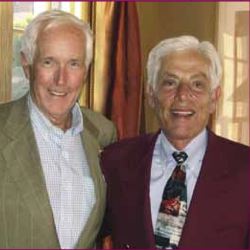
Dr. Hanna spent part of his career serving patients with heart conditions all over the world. Now retired, he
took 48 medical trips to 28 countries and in each country was the first cardiac surgeon to ever perform bypass
surgery there. Upon his retirement, he had performed more than 24,000 open-heart operations. He now
devotes much of his time to the winery but continues to serve as founder and president of Elias S. Hanna, M.D.
Cardiovascular Foundation, a charitable organization that assists countries that lack resources necessary to
perform open-heart surgery.
Hanna’s family grew crops including grapevines in Syria. When he moved to San Francisco, he missed the
pace of farm life. Beginning with 12 acres of vines and a ramshackle farmhouse in the Russian River Valley
purchased in the 1970s, he and his children started making Chardonnay and Cabernet Sauvignon at home. In
mid 1985, he hired Merry Edwards as winemaker, expanded vineyard holdings, and established Hanna Winery
on Occidental Road in the Russian River Valley. Today, the Hanna family owns 600 acres, 250 of which are
planted, split between four different vineyards. The Home Ranch at the winery facility is the flagship vineyard,
with 25 acres planted to Chardonnay and Pinot Noir. The Home Ranch Block 3 was planted to three clonal
selections from Torres, Cambria and Mondavi in 1992. In 2008, an additional 12 acres was planted using
budwood from the original Block 3, along with some clone 667.
Dr. Hanna’s eldest daughter, Christine, is the winery’s President and has been running the winery for over 20
years. Currently, the winery produces 50,000 cases of multiple varietals including Pinot Noir, about half of
which is Russian River Valley Sauvignon Blanc. The winemaker is University of California at Davis graduate
Jeff Hinchliffe.
There are two Sonoma County tasting rooms: the Alexander Valley Hospitality Center is located at 9280
Highway 128 in Healdsburg and is open daily. This venue is home to the winery’s flagship Cabernet
Sauvignon and Merlot. The Russian River Estate and Hospitality Center is located at 5363 Occidental Road in
Santa Rosa and is also open daily. This intimate tasting room is surrounded by Chardonnay and Pinot Noir
vines. Various special wine tastings are available by appointment. The wines are sold online on the winery’s
website at www.hannawinery.com. Listen to Christine talk about Hanna Winery & Vineyards on Grape Radio,
Show 321, April 8, 2013.
2012 Hanna Estate Grown Russian River Valley Sauvignon Blanc
13.2%
alc., pH 3.20, 26,000 cases, $19. 63% of the blend came from the estate Slusser
Ranch Vineyard. Average harvest Brix 22.3º. Fermented and aged in stainless
steel on the lees.
·
Straw yellow color with a slight tinge of green and clear in the
glass. Aromas of limes, yellow grapefruit and cut grass. The grassy theme
carries over on the palate in a New Zealand style with added flavors of lime zest,
green apple, and a hint of green pepper. The hi-tone acidity leaves a refreshing
impression on the crisp finish. Good.
Larry Londer, M.D.: Londer Vineyards
Undergraduate: Chemistry
Graduate: Master’s Degree in Health Administration
Medical School: University of Colorado Denver School of Medicine
Board Certification: Ophthalmology
Dr. Londer worked in a liquor store across the street from the medical school he was attending in the 1960s in
Denver. He stocked the shelves and did deliveries, but when the store was quiet, he would go in the back and
study. While he had no interest in hard liquor, and did not like beer, wine fascinated him and he knew a little
about it. Over time, he learned as much as he could about wine, particularly wines from France and Italy, and
began to drink and enjoy wines that he could afford. He can remember drinking Gallo Hearty Burgundy, but
could not afford to buy most French wines, which were less than twenty dollars a bottle during his medical
training.
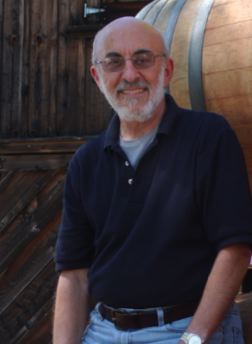
Once he began practicing ophthalmology in Albuquerque, New Mexico, he began collecting wine, joined wine
clubs, and started a gourmet and wine group which met monthly. When the New Mexico Symphony got into
financial trouble, someone suggested a wine auction to raise money. Dr. Londer’s spouse, Shirlee, became
their general chairperson and he was in charge of sourcing wine donations for the auction. Together they
visited and met with the principals of dozens of wineries. The more they visited California, the more they
wanted to “retire” and start a winery in Northern California. They would say, “This is heaven and maybe we
should retire here.” Along with begging for wine donations, they started looking for land and wineries for sale.
In 1999, the couple left New Mexico after Dr. Londer’s 27 years in practice, settling in the Anderson Valley just
outside of Philo on a 53-acre rural estate to start Londer Vineyards. Londers’ family and friends saw the move
as “bold, brave, gutsy and just plain nuts.” They did not know a soul when they arrived but the Anderson Valley
is made up of many people who came from somewhere else, so they quickly assimilated. A small, 16-acre
estate vineyard was planted (15 acres of Pinot Noir and 1 acre of Gewürztraminer), and they set about
sourcing grapes to produce additional Pinot Noir and Chardonnay. Winemaker Greg La Follette got them
started with their first releases in 2001, and Dr. Londer learned most of the winegrowing and winemaking
aspects of a winery during his 4-year apprenticeship with La Follette. Richard Davis, who worked with La
Follette for many years, eventually took over the winemaking duties. Veteran winemaker Eric Stern became
the consulting winemaker in the spring of 2012.
Londer Vineyards wines have received many accolades and the winery helped lead a revolution in Anderson
Valley Pinot Noir over the past 15 years. Their Pinot Noir lineup varied, but usually included an Anderson
Valley, Ferrington Vineyard, Estate Grown and Paraboll (a reserve) bottling. Total production reached 6,500
cases. A modern tasting room was opened in downtown Boonville that brought many visitors to the Anderson
Valley.
Dr. Londer told me, “The winery is like Chemistry 101 and relatively understandable to physicians with a
chemistry background. That coupled with an acquired taste for wine leads physicians to think they can
successfully run a winery. Physicians are often naive because they usually have little or no background in
viticulture, sales and marketing. If those can be learned, then the project has a chance of succeeding.”
In 2011, the Londers sold their home and estate vineyard in Anderson Valley to a neighbor and initially
managed the winery from their home in their native Colorado. The rigors of travel selling their wines, the
operation of a full time tasting room, and the demands required in the management and marketing side of the
winery had taken its toll. In May 2013, they left the business completely to devote more time to their children
and grandchildren in Colorado. The winery is selling off its remaining inventory.

2009 Londer Vineyards Ferrington Vineyard Anderson Valley Pinot Noir
14.4% alc., $45.
·
Moderately dark reddish-purple color in the glass. Lovely perfume of fresh dark berries and black
grapes with spice in the background. The flavors echo the nose with added hints of cola, sassafras,
oak and chalky earth. Very tasty with a graceful and polished demeanor, and impeccable balance. The
very long finish is flush with fruit and citrus-driven acidity. A superb wine from a cherished vineyard.

2010 Londer Vineyards Paraboll Anderson Valley Pinot Noir
14.5%
alc., $24.99 (SR $54 but discounted at retail stores due to closing of
winery - this price is at Bottle Barn in Santa Rosa). A Reserve bottling
sourced from Ferrington and Valley Foothill vineyards.
·
Moderate
reddish-purple color in the glass. Very shy aromatics revealing delicate
scents of dark red cherries and berries. Beguiling core of perfectly ripe
black cherry and black raspberry fruit with balanced tannins and
tempered oak. Soft and smooth on the palate, finishing with grace and intensity.
The powerful and lengthy finish is the most impressive feature of this wine. Still
could use more time in bottle, or decant if you must drink now. A steal at this
price.
Kerith Overstreet, M.D.: Bruliam Wines
Undergraduate: Cornell University, English Literature, 1994
Medical School: University of Rochester School of Medicine and Dentistry, New York, 1998
Residency: University of California at San Diego Medical Center, 2000-2003
Board Certification: Pathology
Dr. Overstreet is the only female physician winemaker I am aware of other than Laura Catena, M.D.. After
completing her training in Pathology, she practiced briefly at Kaiser San Diego, leaving after the birth of her
son. Two years later, twin girls arrived. A cool fact is that an abnormally high percentage of female pathologists
who also completed Dr. Kurt Benirschke’s placenta pathology fellowship went on to have twins. Although she
was recruited to return to medicine, the germ of Bruliam Wines was born and she never returned to the
practice of medicine.
Interestingly, during the one year hiatus between her surgical internship and pathology residency, she did a
stint at the now defunct College of Food in San Diego, intent on eventually transferring to the California
Culinary Academy. She had aspirations to be a chef, and it was great fun, but never pursued this seriously.
Dr. Overstreet started getting serious about wine while in medical school. Each fall, a fellow student and she
would split a case of Beaujolais Nouveau. This was a significant upgrade from the “Gato Negro” she drank in
college. By the end of residency, she became part of a full-fledged wine tasting group. Never mind that the
thematic content included “Box Wines and White Trash Food,” a tasting at which she made a Dorito casserole
and wore an orange house dress.
Dr. Overstreet made her first barrel of Pinot Noir in 2008 at Crushpad in San Francisco. She had planned for
50 cases, but had to dump the Anderson Valley barrel due to smoke taint. She said, “It was love at first crush.
The ineffable mix of science and art was intoxicating.” She increased production and stayed at Crushpad for
through the 2009 vintage. Concurrently, she completed the enology certificate program at University of
California at Davis. She finally shook the Crushpad “training wheels” in 2010 when she crushed a small lot of
Rockpile Zinfandel at Mauritson Winery in Healdsburg where she now continues to craft her wines.
The name, Bruliam stands for the amalgamation of her children’s names, Bruno, Lily and Amelia. Since her
passion for wine and family imbues everything she does, it is “elemental to her life,” and the winery’s tagline is
“Wine is Elemental.” She therefore settled on a logo that riffs on The Periodic Table of Elements. She says,
“Since cadmium, boron and polonium were already taken, we had to settle for our own imaginary element.
One part nerdiness plus two equivalents love and passion makes for great wine.”
The Overstreets fell in love with Healdsburg on their honeymoon and finally moved permanently to Healdsburg
in 2011. She began to make more contacts for fruit sources, seeking out the best growers and purchasing top
shelf fruit. She was both naive and fearless about cold calling famed growers and asking for 1 to 2 tons of fruit.
Some of them laughed out loud at her request, but all of them ended up agreeing to work with her after she
bribed them with homemade cakes, pies and galettes, a tradition that continues to keep her in their good
graces.
After five years of production, Dr. Overstreet finally understands what she wants to do with her wines and
knows how to accomplish those goals. Recently, the Overstreets bought a small Pinot Noir vineyard (formerly
Two Sisters, now named Torrey Hill) of old plantings of Martini clone in the Russian River Valley, but will
continue to work with their grower partners in the Anderson Valley, Sonoma Coast and Santa Lucia Highlands.
Bruliam was envisioned as a not-for-profit venture from the beginning. Fortunately, her spouse, Brian, can
support the family through his business. Dr. Overstreet believes in karma, service and contribution. Bruliam is
an expression of her desire to give back not only dollar value philanthropy, but also because her life is so
blessed. She can pursue a passion on her own terms, and she is humbled with gratitude. Her philanthropic
choices include the arts, arts education and programs for veterans.
For Dr. Overstreet, her medical training has made her comfortable with biology and chemistry and the science
of winemaking comes easy. She notes, “Yeasts are the same, whether they are infecting a patient, proofing
bread, or making wine. The art part is more ephemeral.” Today, when asked to speak at industry events, she
leads off with a picture of her performing an autopsy during her first year of residency (see photo above) and
follows that with a picture of her harvesting grapes on a beautiful fall morning. It vanquishes any questions
about why she chose to do what she does.
Bruliam Pinot Noirs, Rosé of Pinot Noir and Rocky Ridge Vineyard Zinfandel are sold through a mailing list,
with all proceeds donated to the Overstreet Family Foundation. The wines are also available online on the
winery website at www.bruliamwines.com. Dr. Overstreet is quite an accomplished writer with a good sense of
humor and can be followed on her Bruliam Wine Blog.

2012 Bruliam Sonoma County Rosé of Pinot Noir
14.5% alc.,
$20. A saignée of Pinot Noir after 24 hours of skin contact. Fruit is
from the Russian River Valley (estate Torrey Hill Vineyard) and
Sonoma Coast (Gap’s Crown Vineyard). Fermented and aged in
stainless steel kegs after inoculation. No MLF. LIghtly fined for
clarity.
·
Light pink-coral color and clear in the glass. Fresh aromas of
strawberries, watermelon, cherry glaze and dried herbs. The flavors
echo the nose with some welcome spice. A subtle riff of dried herbs adds an
appealing savory accent. The wine is dry and refreshing and not in the tutti fruity
genre of rosés. I would drink it with sushi. Very good.
2011 Bruliam Gap’s Crown Vineyard Sonoma Coast Pinot Noir
14.3% alc., pH 3.46, TA 0.462, $55.
Picking began a day before September rains. Clone 115. 100% de-stemmed. Saignée for a rosé was
followed by minor acid and water additions to replace the volume lost. Aged 10 months in 20% new French
Radoux oak barrels and 80% Radoux seasoned oak barrels. Aged 9 months in bottle before release.
·
Moderately light reddish-purple color in the glass. The nose is enchanting, starting out with aromas of black
cherries and evolving to more complexity with scents of sassafras, bark, cola and cinnamon. Elegant and
tasty, with mid weight flavors of black cherries and black raspberries and undertones of oak and anise. The fruit
is well-framed by good acidity and gentle tannins. The finish is fruit-driven and charming. Very good.
Craig Senders, M.D., FACS: Senders Wines
Undergraduate: Oregon State University, General Biology, 1975
Medical School: University of Oregon Health Sciences Center, 1979
Residency: Otolaryngology and Maxillofacial Surgery, University of Iowa Hospitals & Clinic, 1980-1984
Board Certified: Otolaryngology
Dr. Senders is a Professor of Pediatric Otolaryngology at University of California at Davis where he specializes
in facial birth defects like cleft lip and cleft palate. He grew up in Portland, Oregon, and practiced in the
Midwest before coming to Davis in 1984. He has served as the director of the Cleft and Craniofacial Program
at the University of California at Davis for over 25 years, and was the director of the residency program in
Otolaryngology there for 15 years. He is an expert in cleft lip and cleft palate, endoscopic sinus surgery, and
surgery for sleep apnea.
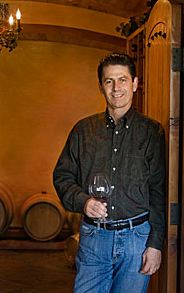
When Dr. Senders moved to Davis, he had only a passing interest in wine. He then began to assist his
neighbor who made wine at home, became attracted to winemaking, and began making wine at home. He
soon had success and won many awards for his home-crafted wines. Eventually Senders Wines was
launched and released its first wine from the 2005 vintage. The small winery specializes in small lots of
Cabernet Sauvignon from Napa Valley and Pinot Noir from the Russian River Valley, Sonoma Coast and
Carneros. Dr. Senders makes his wines at Bin to Bottle, a custom-crush facility in south Napa, only 45 minutes
from Senders’ home, and his spouse Karen markets and sells the wines.
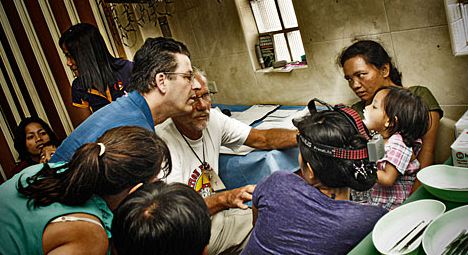
100% of the profits since the inception of the winery in 2005 are used to support medical outreaches for
children and adults with cleft lip and cleft palate. The winery’s byline is “Wines with a Cause.” Dr. Senders has
participated in over 30 pro bono outreaches through the Face to Face organization, performing cleft lip and
cleft palate surgeries for children and adults who cannot afford his operations. In this manner, he is able to
blend his passion for practicing medicine, handcrafting fine wines, and supporting medical outreaches
throughout the world. He has won several humanitarian awards for service to the less fortunate in the world.
Senders Wines donates $100 to medical outreaches for every new Wine Club membership. The wines are
sold online at www.senderswines.com.
2009 Senders Reserve Sonoma Coast Pinot Noir
14.2% alc., pH 3.73, TA 0.61, $45. Sourced from Old
Adobe Road Vineyard in the Petaluma Gap, clones 667 (70%) and 777 (30%). Aged 11 months in 50% mew
Billon French oak barrels.
·
Moderate reddish-purple color in the glass. Aromas of cherries, dark chocolate,
black olive and mushroom. Tasty, middleweight flavors of cherries with hints of chocolate and sassafras and
oak in the background. Soft in the mouth with some finishing presence. Good.
2010 Senders Las Brisas Carneros Pinot Noir
13.9% alc., 170 cases, $38.
Sourced from Las Brisas Vineyard, clones 667, 777 and Swan. Aged 18 months
in French oak barrels.
·
Moderate reddish-purple hue in the glass. The nose
offers appealing aromas of fresh cherries, forest floor and herb garden. Vivid
black cherry and dark red berry fruits are featured with a finishing touch of spice.
The tannins are nicely balanced, the texture is silky, and the black cherry really
sings on the well-endowed ending. Very good (+).
F. Wells Shoemaker, M.D.: Salamandre Wine Cellars
Undergraduate: Stanford University
Medical School: Stanford University 1972
Residency: Stanford University Hospital and UCLA Harbor Medical Center
Board Certification: Pediatrics
Dr. Shoemaker spent six months studying in Florence when he was nineteen and it was there that he met with
wine as a matter-of-fact, pleasant, and unpretentious part of the evening meal. Wine wasn’t a “score” that he
had to make with a fake ID in a liquor store. It wasn’t a sexual thrill and it wasn’t a macho overture. It was just
supper. The Tuscan families introduced him to the customs of winemaking, to an understanding of history in
the soil, to a sense of respect among generations, and to the practice of sharing with strangers.
He returned to Stanford University, and based on his exposure to the humanities in Italy, he switched his major
from metallurgical engineering to medicine. He became involved with a farm worker organization in the San
Joaquin Valley and helped establish a free clinic for migrant workers known as the Livingston Community
Health Center.
Medical school and pediatric residency followed, and Shoemaker realized that there was a world of wine that
he could not afford. A friend introduced him to Ridge Zinfandels of the 1960s, and those became his standard
of quality.
After settling into practice in the Monterey Bay area, he founded the first intensive care nursery in the region,
and launched one of the first hospital-based lactation centers in Northern California.
Dr. Shoemaker learned how to taste and understand wine by visiting wineries, and finally decided he wanted to
do it himself. As he said, “I guess I’d rather be a wine player than a wine Spectator.” He started as a home
winemaker and took many courses from the University of California at Davis Extension. His wines did well in
competitions, and in 1985, he opened Salamandre Wine Cellars as a commercial, bonded winery, with partner
Dave South, M.D., a dermatologist.
In the early 1980s, Shoemaker began collecting medical information about wine, wrote about wine and health
for several trade journals, and served as Chairperson of the Scientific Advisory Board to the Wine Institute of
California. California wineries were uneasy with his role as science advisor because it is illegal for a
winemaker to state anywhere on a container or in any winery sales information anything that even remotely
implies a health benefit to any alcoholic beverage. The gray area of concern was whether a physician could
write something scientifically valid about health effects, whether positive or negative, in a printed article other
than a sales article if that physician was also a licensed winemaker. Shoemaker had to be very cautious about
that gray border.

Along with Lewis Purdue and Keith Ian Marton, M.D., Shoemaker wrote the book, The French Paradox and
Beyond (1992). He appeared on the cover of the AMA News in the mid 1990s that contained an article on why
doctors get into wine. A reader from one of the slave states wrote in a letter to the editor that Shoemaker was
a traitor to the Hippocratic Oath by saying anything good about killer alcohol!
When he lectured to medical and winemaking groups on wine and health, the winemakers would often remark,
“Here is another dilettante doctor tax-dodger getting into the wine business.” Other doctors would say politely,
“Well, how can be objective since you’re making all that money in the wine business.” For the doctors, he had
to remind them that he did not choose pediatrics for its investment potential and small winery economics
(Salamandre produces about 2,000 cases a year) are financial foolhardiness. It took seven years of dedicated
labor for Salamandre to break even.
Shoemaker has now been making wine for 29 years and is proud of the quality of his work, but it is a distant
second among his professional priorities, and it does not come up much these days in his medical interactions.
He crafts a number of different varietals, but Santa Cruz Mountains Pinot Noir has been one of his most
popular wines.
Since 2000, Shoemaker has relinquished his participation in the public interface and spends all his energies on
population-based delivery system reform as the Medical Director of the California Association of Physician
Groups. He is also a member of the Governor’s task force, writing a ten-year plan for California, and a
spearhead for an exciting new primary care institute.
Shoemaker told me that was once asked by the wife of a minister how he could dedicate his life to helping
children, then turn around and make “alcohol.” Shoemaker reminded her that Jesus performed his first miracle
by transforming seven stone cisterns of water into wine. His mother urged him to do it, since there was no
wine to properly celebrate the wedding in Cana. Shoemaker pointed out that the medical and clerical paths
have been intertwined with wine throughout the history of human civilization.
On the relationship of doctors and wine, Shoemaker says the following. “Beyond the intrigue of the unfolding
awareness of the relationship of moderate drinking and a variety of health measures, medical training is really
useful in other ways in the cellar. To make wine successfully, one must maintain constant suspicion that Nature
is not being kind or generous. The same attentiveness to subtle signs of distress that I have used for decades
in the nursery, serves well to intercept problems in the barrels. The pleasure in seeing a fine wine safely
through to bottling will never parallel the joy of seeing healthy babies go home with loving mothers, but the
hours are more humane, and wine smells better. It is also hard to carry babies to the beach, the mountains,
and the desert without lugging a lot of extra stuff. Been there, done that, and now we just pack the corkscrew.”
Salamandre wines are sold through a mailing list and on the website. The wines are reasonable priced. As
Shoemaker says, “Don’t pay ridiculous dollars for Ego Noir that’s still trying to draft on ‘Sideways’.” The winery
is not open to the public but periodic open houses and invitational tastings are held at the winery which is
carved into the hillside next to Shoemaker’s home located in a shaded redwood canyon two miles inland from
the beaches of Aptos. The Salamandre Wine Cellars website is www.salamandrewine.com.
2009 Salamandre Meadowridge Vineyard Santa Cruz Mountains Pinot Noir
14.6% alc., $34.
·
Moderate
reddish-purple color in the glass. Gracefully perfumed with aromas of black cherry, raspberry and new oak.
The flavors echo the nose with added notes of plum and spice. Complimentary tannins and bright acidity
combined with a pleasing and generous finish make for wonderful drinking. Very good.

2010 Salamandre Santa Cruz Mountains Pinot Noir
13.7%
alc., $32.
·
Moderately deep purple color in the glass. Lovely
perfume of dark berries, fresh picked plums and spice. The
aromas are captivating. My notes say WOW on entry. Really
delicious, moderately intense flavors of dark berries, black
cherries and plum with a hint of spice. The fruit reaches every
nook and cranny in the mouth, expanding to finish with
unbelievable length and aromatic focus. A complete, harmonious wine of
exceptional quality and sure to be one of my All Americans for 2013. (Not listed
on website so call or email to order)
Robert M. Sinskey, M.D.: Robert Sinskey Vineyards
Undergraduate:
Medical School: Duke University School of Medicine 1948
Residency: Duke University School of Medicine
Board Certification: Ophthalmology
From 1951 to 1953, Dr. Sinskey was assigned to the Atomic Bomb Casualty Commission in Hiroshima and
Nagasaki, Japa, where he studied the eyes of bombing victims. Dr. Sinskey was the first full time staff
ophthalmologist at UCLA in 1955 and opened its eye clinic. He also founded the Southern California Lion’s
Eye Institute.
A pioneer in cataract surgery techniques and surgical instrument innovation, he developed the use of
intraocular lenses following cataract surgery and was the first American surgeon to perform the procedure on
infants and children. His patented J-loop intraocular lens was widely used as were several of the surgical
instruments he invented. He taught small incision cataract and intraocular lens implant surgery to more than
3,000 ophthalmologists at the Sinskey Eye Institute in Santa Monica (including myself) which he founded in
1960. From 1999 to 2000, he served as president of the American Society of Cataract and Refractive Surgery
(ASCRS). Dr. Sinskey has been the driving force behind construction and equipping of the ASCRS
Foundation’s Robert M. Sinskey Eye Institute in Addis Ababa, Ethiopia. The Sinskey Eye Institute treated over
13,000 patients in 2012 with a full time staff of twelve including two ophthalmologists. He retired from the
practice of ophthalmology in 2000.
Dr. Sinskey authored a book on his career including a medical history of phacoemulsification and his role in
ushering in modern cataract surgery: A Life in Focus (2010).
Dr. Sinskey was an investor in Acacia Winery in Carneros in 1980, began planting grapes in Napa in 1982, and
established his own eponymous winery now located in the Napa Valley in 1987. From a humble beginning of
15 acres of vineyard land, Robert Sinskey Vineyards now has just under 200 acres of prime vineyards
including five Napa Carneros sites and a small 4.8-acre estate vineyard adjacent the winery which is in the
Stag’s Leap District of Napa Valley.
His son, Rob Sinskey, eventually took over winery operations and winegrowing duties, and the winemaker
since 1991 has been Jeff Virnig. Pinot Noir is the focus of the winery and has been produced since 1986. The
winery has a reputation for organic and biodynamic farming. Stylistically, the Pinot Noirs are relatively low in
alcohol, elegant, with minimal oak encumbrance. The winery’s Vin Gris of Pinot Noir Rosé, produced since
1991, is outstanding. The Pinot Noir lineup includes: Los Carneros Pinot Noir, Three Amigos Vineyard Los
Carneros Pinot Noir, Vandal Vineyard Los Carneros Pinot Noir, Capa Vineyard Los Carneros Pinot Noir and a
Reserve labeled Four Vineyards Los Carneros Pinot Noir.
The tasting room is located at 6320 Silverado Trail in Napa and is open daily. The wines are also sold online at
www.robertsinskey.com. Visit the informative website’s Vineyard Kitchen which includes seasonal menus and
recipes from Maria Helm Sinskey.

2012 Robert Sinskey Vineyards Los Carneros Vin Gris of Pinot Noir
13.1% alc, $28 (allocated).
Whole cluster pressed.
·
Light orange color and clear in the glass. Aromas of strawberries, oranges
and melon. Many flavors emerge over time in the glass including strawberry, cherry, blood orange,
peach, and herbal tea. A highly pleasurable rosé that has its own unique vibe and plenty of pizzazz.
Very good.
2009 Robert Sinskey Vineyards Los Carneros Napa Valley Pinot Noir
13.4% alc., 6,900 cases, $38. Made from organic grapes.
·
Moderately light
reddish-purple color in the glass. Well perfumed with aromas of fresh black
cherries and black raspberries. Earth-kissed flavors of black cherries, dark
raspberries and spice with balanced tannins and good supporting acidity.
Finishes with reasonable cherry-driven aromatic intensity. This wine has some
artisan qualities that one doesn’t expect from such a large production. Good.
Eric Sterling, M.D.: Esterlina Vineyards & Winery
Undergraduate: University of California at Irvine, Biology and Biological Chemistry
Medical School: California College of Medicine & Surgery 1988
Board Certification: American Board of Emergency Medicine
Years before ‘Sideways,’ Dr. Sterling, along with Santa Rosa radiologist Frank Cutruzzola, M.D. (profiled earlier
in this article) became intrigued by the grape and wine business. Dr. Sterling ended up founding Esterlina
Vineyards & Winery in the Anderson Valley along with other family members, and Dr. Cutruzzola bought a Pinot
Noir vineyard on the Central Coast.
Dr. Sterling first became interested in wine mainly as a consumer. He had no real interest in making wine until
he bought his first vineyard and made wine from the second crop after noticing how many grapes were left over
after harvest. He made his first wines in his barn and they were surprisingly good. He says his background in
biochemistry served him well and he found that the science of winemaking was not difficult. He took a few
classes in winemaking, read many books, and talked with several winemakers and started to focus on the style
of wine he preferred. He then bought the Esterlina property that would allow him to grow grapes in that style.
Sterling told me, “People are generally happy in the wine business in contrast to medicine where long hours,
stress and the difficult work environment takes its toil. Wine tasters are out to enjoy themselves, and wine is
something that people drink when they are relaxing or celebrating. I felt that growing grapes and making wine
added balance to my life. That balance is crucial for without it, I would not be as effective in my job and in my
life.”
He also said, “I think physicians are attracted to winemaking for many of the same reasons they pursued
medicine. Both are an art and science. Winemaking allows for development of both halves of our brains.
Plus, it’s fun and satisfying to create something from start to finish. I have a full time winemaker now, but still
enjoy the winegrowing and blending process. I will go back to full time winemaking when my medical career
ends.”
Esterlina Vineyards & Winery is a family operation under the direction of father Murio and his sons Eric, Craig
and Steve, specializing in Pinot Noir from the estate vineyard high above the Anderson Valley floor. The site
was the former Pepperwood Springs Winery, purchased by the Sterling family in 2000, and rechristened
Esterlina which is Spanish for sterling. The Esterlina Pinot Noirs are all from estate fruit and include an
Esterlina Vineyard, a Riserva, and a Cole Ranch bottling.
The Sterlings also own the 253-acre Cole Ranch AVA in Mendocino County, the smallest AVA in America where
the sole vineyard is planted to Pinot Noir, Cabernet Sauvignon, Merlot and Riesling. They also own Alexander
Valley Ranch (Everett Ridge Vineyards & Winery) which produces Cabernet Sauvignon and vineyards in the
Russian River Valley (Chardonnay and Pinot Noir.
Tasting at Esterlina Vineyards & Winery is by appointment and is well worth the circuitous 2.5-mile drive up a
dirt road to the winery at 1200 Homes Ranch Road in Philo (707-895-2920).

2009 Esterlina Esterlina Estate Vineyard Reserva Anderson Valley Pinot Noir
14.5% alc., $65.
·
Moderately light reddish-purple color in the
glass. Ripe fruit profile featuring blackberry and boysenberry aromas
with a hint of oak. Opens beautifully over time in the glass, building
gradually in intensity and interest. Flavors of dark red cherries and
berries and plum with accents of black tea and cola. Despite its
concentration of fruit, the wine retains a refreshing character and is light
on its feet. Mild fine-grain tannins add to the appeal. Decant if you open now,
but patience will be rewarded.
2010 Esterlina Esterlina Estate Vineyard Anderson Valley Pinot Noir
14.4% alc., $N/A.
·
Light reddishpurple
color in the glass. Aromas of oak-kissed red fruits including strawberries with hints of cedar. Moderately
light on the palate, yet noticeable staying power on the long finish. Delicious over time in the glass offering
flavors of red and blue berries, baking spice, and subtle oak. Easy to like and very giving. Very good.

2010 Esterlina Cole Ranch Reserva Cole Ranch Pinot Noir
14.5% alc., $N/A.
·
Light reddish-purple
color in the glass. Fresh aromas of brown sugar dusted ripe strawberries and an array of other red
fruits. Moderately light in concentration, but plenty of charm and elegance. Juicy, with supple tannins
and a persistent, fruit-filled, electric finish. Cause for celebration.
Anthony Truchard, M.D.: Truchard Vineyards
Undergraduate: University of Texas in Austin, Chemical engineering
Medical School: Southwestern Medical School in Dallas, Texas
Residency: Fort Sam Houston Brooke Medical Center, Internal Medicine
Board Certification: Internal Medicine
Dr. Truchard was born and raised on a farm in Sealy, Texas where his grandfather, Jean-Marie Truchard, an
emigrant from France in 1885, had planted a vineyard and built a winery in the late 1800s. The vineyard did
not survive the hot, humid weather in Sealy, which was close to Houston, so he turned the winery into a barn
and raised cattle like all of his neighbors, adding vegetable gardens and pecan, orange and pear orchards. Dr.
Truchard learned about agriculture growing up on that farm, but he decided he wanted to become a physician.
Dr. Truchard met and married Jo Ann, who was from La Grange. A graduate of the University of Texas, she
taught school while he attended medical school. He entered the army his senior year of medical school and
after interning at Walter Reed Medical Center and completing his internal medicine residency at Fort Sam
Houston Brooke Medical Center, he was sent to Sierra Army Depot in Herlong, California (60 miles north of
Reno, Nevada) from 1972 to 1974 to repay his military stipend he used to finish his schooling. Initially, Dr.
Truchard was to be sent to Korea, but a month before he was to leave, his pregnant spouse, only days before
her scheduled delivery, slipped on a grape exiting a supermarket (true story) and broke her knee. Dr. Truchard
told the military he could not leave his wife, and four days later, their son John was born. Instead of being sent
to Korea, the family was sent to Herlong, the site of a secret nuclear arsenal. The Truchards lived next door to
the commander of the Depot, and were invited to many army functions where they had their first experiences
with good wine.
In 1972, only a month after they moved to Herlong, Dr. Truchard had to report to the San Francisco Presidio.
Afterwards, he and Jo Ann took a drive through the Napa Valley before heading home and the idea of farming
wine grapes clicked. Shortly thereafter, impressed by the vineyards he saw and driven by the desire to return to
his farming roots, he decided to return and look for property where he could plant a vineyard. He was shocked
at the price of property in the Napa Valley compared to the price of land in Texas, and frustrated as he was still
on a military salary.
A realtor directed the Truchards to Carneros where real estate was less expensive. He found them a 21-acre
hillside prune orchard for sale for at $1,589 per acre on Old Sonoma Road, but it lacked water and the soils
were very shallow. People told the Truchards they couldn’t grow grapes in this area of deserted orchards. In
the early 1970s, the primary method of watering was to dig a well and use overhead sprinklers but the property
had no ground water. The realtor arranged for them to meet with a local vineyard manager from the Krug
ranch who suggested they dig a reservoir, collect winter rains, and then use drip irrigation. This method had
been developed in Israel to water in the desert and was relatively new to viticulture in California. Without drip
irrigation, it would have been impossible to successfully establish and grow wine grapes in Carneros. They
decided to follow that advice, and bought the property in 1973 while Dr. Truchard was on active duty, with the
intention of tending to the property on weekend visits.
At the time, there was only about 300 acres of wine grapes in the Carneros - the Krug ranch, BV, Martini’s
Stanley Lane Vineyard, Rene di Rosa’s Winery Lake Vineyard, and Francis Mahoney’s Carneros Creek nearby.
Francis Mahoney helped the Truchards select budwood and rootstocks, plant the vineyard, and agreed to buy
the grapes. Beginning in 1974, they planted Pinot Noir, Cabernet Sauvignon, Merlot, Cabernet Franc and
Chardonnay. The Truchards soon began selling fruit to various Napa wineries who welcomed their grapes.
Miraculously, over the next 40 years they were able to gradually add adjacent parcels until today they own 400
contiguous acres of which 285 acres are planted to ten varieties of wine grapes. What cost $1,589 per acre in
1973, had escalated to $17,000 per acre in the 1990s and today would be over $100,000 per acre.
Early on, Dr. Truchard not only found he could make more money selling grapes than practicing medicine, he
enjoyed farming more. Dr. Truchard left the Army in 1974, and continued to practice internal medicine in Reno,
Nevada, traveling on weekends with the family (they ultimately had six children), living in a travel trailer while
they worked on the vineyard.
An old barn on the property was converted into a winery in 1989, it was bonded in 1990, and the Truchards
began making wine for themselves using estate grown fruit. The barn is very similar to the original Texas
winery that Dr. Truchard’s father had built in 1895. It has become the symbol for Truchard Vineyards and
adorns the wine label. A 10,500-square-foot wine cave was added later (see entrance above). Today they have
six reservoirs on the property to collect rain.
Dr. Truchard loves cats and when I visited, the feral black cat pictured above showed considerable love for him,
much like a dog and highly uncharacteristic of a feral cat. When asked how many cats he had, Dr. Truchard
simply smiled and said, “Too many to count.”
Dr. Truchard retired from medicine to tend his vast vineyard and devote all his time to viticulture. His
background in chemical engineering has come in handy both in the vineyard and in the winery.
The winemaker at Truchard Vineyards since 1998 has been University of California at Davis graduate Sal De
Ianni. Today, fifteen different varietals are produced, amounting to 15,000 cases per year. 70 percent of the
grapes produced are still sold to about twenty-six Napa wineries. Wineries sourcing Truchard grapes have
included David Bruce, Picchetti, Jessup, Saintsbury, Acacia, Bouchaine, Carneros Creek and Artesa.
The second generation, including Anthony Truchard II, has taken over management of the winery. Jo Ann told
me that after Dr. Truchard retired from medicine, he spends all his time outdoors and refuses to sit behind a
desk. After a marriage lasting 49 years so far, she tries to help him by handling the desk work for him. She
was kind enough to supply much of the information reported here and give us a tour of the Truchard property.
She said that they are often asked what draws physicians to wine and she is not really sure of the answer.
“Maybe it is the appreciation of the finer things of life.”
Tours and tastings are available by appointment Monday through Saturday (707-253-7153) at 3234 Old
Sonoma Road in Napa. The website is www.truchardvineyards.com.
2011 Truchard Carneros Napa Valley Pinot Noir
14.1% alc., $35. Recent
release with revamped, modernized label. Seven clonal selections in the blend.
·
Moderate reddish-purple color in the glass. The nose unfolds slowly in the glass
revealing compelling aromas of darker berries, mushrooms and clove-scented
oak. Dark red and black fruits are featured with a pleasing earthiness and
complimentary oak. Nicely balanced and easy to drink, with a silky mouth feel
and commendable finishing intensity. Should benefit from another 6 to 12
months in bottle. Very good.
Scott Tweten, M.D.: Volamus Vineyards
Undergraduate: Northwestern
Medical School: Tulane University Medical School 1988
Internship: University of Minnesota
Residency: Stanford University Hospital
Board Certification: Anesthesiology
Dr. Tweten is a practicing anesthesiologist who has a Pinot Noir vineyard located in the Petaluma Gap region
of the Sonoma Coast and sells grapes to a number of wineries. He told me the following about the joys of
vineyard ownership. The photo below was taken the day he bottled his first personal effort at winemaking and
he notes, “wine grape growing and winemaking really is a family affair.”
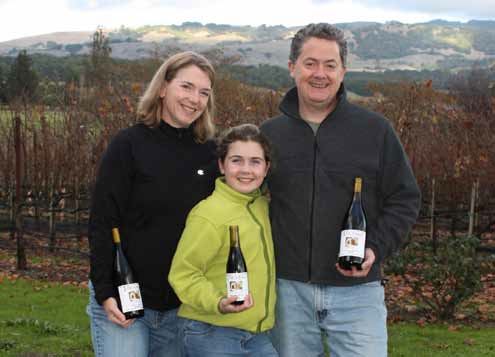
“The vineyard has an annual cycle that is on a scale similar to the gestation of a child. Each season has its
chores and routines. After six harvests, I am finally ahead of the curve and not merely trying to keep up,
although the vineyard managers have made sure things happened when they needed to. Although there is a
rhythm to the season in the vineyard, no two seasons have yet been the same. Spring has been early or late,
with frost or not. Summer has been hot, cool and even non existent. Fall has had rain, Indian summer or too
little head to bring the fruit into balance. Winter has been wet, dry, or brought snow on a nearby mountain.”
“I am beginning to understand what each year has meant to the wine of that vintage, especially now that I have
tried my hand at making my own barrel each year. And, as if the season of the vineyard isn’t long enough, add
an additional year for the rhythm of the wine. Maybe the gestation of an elephant is a better example.”
“Most of my physician colleagues drive nice cars. A few Porsches, many BMWs and one even owns a
DeLorean. For me, I look forward to pulling my Kubota out of the shed and spending a few hours amongst the
vines where the cares of the world don’t reach me.”
You can follow Dr. Tweten’s seasons in his vineyard at www.volamusvineyards.com/blog, “Adventures of a
Gentleman Grape Grower,” a limited work in progress.

2011 Bravium Volamus Vineyard Sonoma Coast Pinot Noir
14.2% alc., pH 3.45, TA 0.61, 96 cases, $34. 4,500 vines on 3.5
acres. Clones 115, 667 and Pommard farmed sustainably. Hand
pressed, 25% whole cluster, racked once after MLF, aged in 50%
new 4-year air-dried Francois Frères oak barrels. Unfined and
unfiltered.
·
Medium reddish-purple color in the glass. A more
serious, complex wine that will benefit from more time in the bottle.
The aromas open slowly in the glass to reveal hi-tone notes of dark berries,
spice, forest floor and a hint of vanilla. Dark berries are the featured fruit with
undertones of dark chocolate, clove and allspice, all wrapped in dry, chalky
tannins, finishing with razor sharp acidity. A little more body, nuance and class than the Sonoma Coast
bottling. Very good (+).
Still more “Pinot Noir Doctors.”
Walter Byck, M.D.: Paradise Ridge Byck Family Winery
Dr. Byck is a graduate of the University of Pennsylvannia Medical School who did his radiology residency at
Cornell Medical Center in New York City. After serving in the military, he moved to Santa Rosa in 1965 with his
spouse Marijke Hoenselaars. In 1994, the couple opened Paradise Ridge Winery and a year after opening the
winery, they launched the first sculpture exhibit in their new Paradise Woods Sculpture Grove. After retiring
from medicine in 1997, Dr. Byck turned all his attention to the growing sculpture project. The second
generation, including Rene Byck and Sonia Byck-Barwick, are co-owners and managing partners in the winery.
Dan Barwick is the winemaker. There are several estate vineyards but none planted to Pinot Noir. The winery’s
Russian River Valley Pinot Noir is a consistently reliable offering produced from sourced fruit. The winery
website is www.prwinery.com.

2010 Paradise Ridge Russian River Valley Pinot Noir
13.3% alc.,
167 cases, $28.99.
·
Medium reddish-purple color in the glass. Lovely
aromas of fresh black cherries, cola, sassafras and baking spices.
Mid weight flavors of black cherries, vivid, crisp and juicy in character,
smoothly textured, and finishing with deep cherry aplomb.
Quintessential Russian River Valley in character. Very good (+).
Warren Frankel, M.D.: Sculpterra Winery & Sculpture Garden
Dr. Frankel, a family doctor, moved to a 90-acre ranch in Paso Robles from the San Fernando Valley in 1979
with his spouse Kathy and their three children. The Frankel family first planted 20 acres of pistachios on the
ranch, followed by 20 acres of Cabernet Sauvignon. He expanded the vineyard operation in 1997 with the
addition of more Cabernet Sauvignon and several other red and white warm climate varieties. The winery and
multi million dollar sculpture garden was opened in 2007. In 2002, Dr. Frankel joined with other doctors to
found “His Healing Hands,” a medical missionary foundation that sends medical missionary teams all over the
world on all five continents. They also respond to catastrophic disasters. He has written about the missionary
work in a book, His Healing Hands.” Along with several varietals, a Paso Robles Pinot Noir is produced. The
website is www.sculpterra.com.
Ray Merlo, M.D.: R. Merlo Estate Vineyards
This winery is located in the Hyampom Valley amongst the inter-coastal mountains of Southern Trinity County
in a rugged region of Northern California. Dr. Merlo and his spouse Robin, a physician assistant, started a
family practice in Redding, California. Their interest in wine had been piqued upon a visit to family in Northern
Italy in the mid 1980s. They visited an old family vineyard planted by Dr. Merlo’s great-grandfather and they
thought it might be worthwhile to continue the family tradition back home. It wasn’t until the late 1990s that the
Merlos entered into a formal partnership with Randall Meredith of Meredith Vineyards, an established, bonded
winery located in Hyampom Valley. They bought Hyampom Valley Ranch and planted a second vineyard in
2000. The first bottling under the Meredith/Merlo label came in 2001. A winery was built in 2002 and a second
winery in 2004, when the first bottling under the R. Merlo label appeared. Merlo, Italian for blackbird, offers
several varietals including Pinot Noir from Southern Trinity County. The estate vineyards are over 45 acres and
include Chardonnay, Pinot Noir, Zinfandel, Syrah, and Merlot. The consulting winemaker is David Georges and
the head winemaker and viticulturist is Steven Canter. The winery website is www.rmerlo.com.
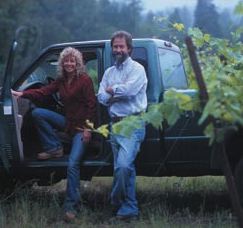
Chris Thorpe, M.D.: Adastra Wines
Dr. Thorpe and Naomi Thorpe moved to Northern California in 1980 and bought the 33-acre Carneros ranch
that was to become Adastra in 1984. Initially, Dr. Thorpe raised Angus cattle, but in 1989 established Adastra
Vineyards, returning the Carneros property to vines for the first time since Prohibition. The vineyard has 7
acres each of Chardonnay and Merlot and six acres of Pinot Noir. Wine production began in 1995 with a small
amount of Merlot. All the Pinot Noir was sold to Etude beginning in 1997 until 2002, when some was withheld
to produce this varietal under the Adastra label. At present, Adastra sells slightly less than half its grapes to
other producers. The vineyards, managed by Dr. Thorpe and his son-in-law Edwin Richards, are CCOF
certified organic. The winemaker is Pam Starr. Dr. Thorpe is a retired Vallejo surgeon. The winery website is
www.adastrawines.com.
Tadeusz Wellisz, M.D.: Malvolio Pinot Noir
A Los Angeles area Plastic Surgeon and developer of medical devices (Biomedics, Inc.) whose wife, Nadia,
and her father, Selim Zikha, bought Laetitia Vineyard & Winery in 2001. Dr. Wellisz produced Pinot Noir under
the Malvolio label with fruit sourced from Laetitia Vineyard in the early 2000s.
Stewart Lauterbach, M.D.: Lauterbach Cellars
Dr. Lauterbach is a Board Certified Emergency Medicine physician currently practicing in Santa Rosa, CA. He grew up in the Chicago area and became a volunteer firefighter and paramedic, which led to his ambition to pursue a medical degree. Dr. Lauterbach is a graduate of the University of Cincinnati College of Medicine (1981) and did his residency in emergency medicine at Highland General Hospital in Oakland, CA. (completed in 1984). Dr. Lauterbach and his spouse Barbara, who was a nurse, acquired a ranch in the Russian River Valley and planted Pinot Noir and Syrah. Barbara eventually pursued a law degree and is Director of Legal Services for the Council on Aging in Sonoma County. Dr. Lauterbach works eleven shifts a month in Sonoma County's trauma center and balances this stressful job by farming his vineyard along with manager Lee Martinelli Jr. and crafting wine from grapes grown in his vineyard with consulting winemakers Dan Goldfield (2000, 2002, 2003, 2004 Pinot Noir and 2000 Syrah), Pax Mahle (Syrah production through 2005), Ron Berglund (2001, 2005 and 2006 Pinot Noir). Stewart and Barbara now produce the estate bottled wines.
Robert Keefer, M.D.: Keefer Ranch
Marcy Keefer, a former nurse, and her husband, Robert Keefer, M.D., purchased the property near the
headwaters of Green Valley Creek in Sebastopol, Sonoma County, in 1985. The vineyard was planted in 1988
on the site of a former apple orchard. Dr. Keefer is now deceased, but Marcy carries on, actively overseeing
the farming of the vineyard, selling grapes to several of California’s most noted Pinot Noir producers, and
bottling a Keefer Ranch Pinot Noir which her son, Craig Strehlow, crafts.
William Hall, M.D.: Gypsy Canyon
Dr. Hall and his spouse Deborah, who was a nurse, bought the 290-acre Gypsy Canyon property in 1994.
After Dr. Hall passed away in 1997, she sold 160 acres and kept 130 acres with 12 acres of vineyards. She
took over winemaking duties upon his passing, and continues to produce ultra-premium Pinot Noir and Ancient
Vine Angelica.
Maurice Galante, M.D.: Dr. Maurice Galante Vineyard
A San Francisco-based surgeon and Professor Emeritus at University of California San Francisco died in 2013.
He bought an apple orchard on Cherry Ridge Road near Occidental in the mid 1980s and enlisted the Dutton
family to plant the Dr. Maurice Galante Vineyard to Pommard clones 667, 777 and Pommard.







